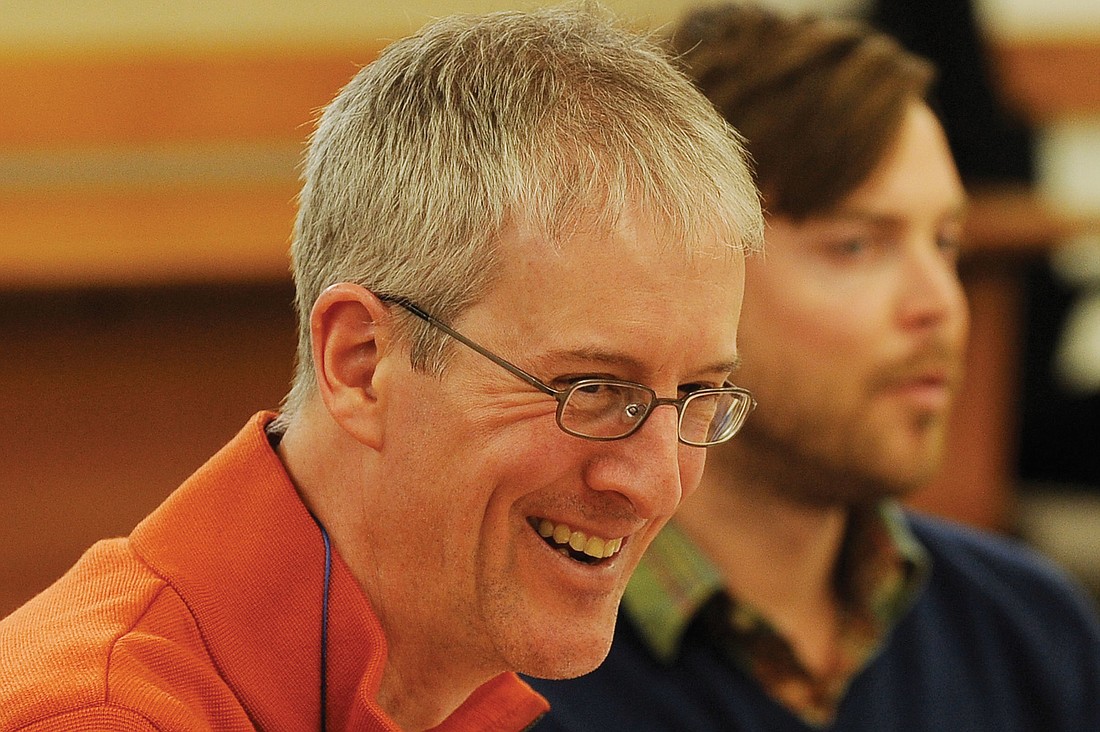- April 17, 2024
-
-
Loading

Loading

Jeff Speck, an architect in Washington, D.C., has spent decades analyzing and designing cities. From his perspective, nothing is more important than creating environments conducive to walking.
Speck will be coming March 20 and 21, to Sarasota.
Downtown advocates, including planner Chris Gallagher and Downtown Sarasota Alliance Chairman Tony Souza, brought Speck to town as part of their effort to gain support to transition downtown into more of an urban, walkable environment.
In November, Gallagher read Speck’s new book, “Walkable City: How Downtown Can Save America, One Step at a Time.”
Speck is expected to talk about density — or the number of residential units allowed per acre. Area proponents of a plan to encourage more affordable housing and a more vibrant downtown environment say it won’t happen unless the city relaxes its density limits.
Another topic will be how to make it more safe and enjoyable for pedestrians.
“Might as well have to swim over a moat,” said Souza about pedestrians trying to cross U.S. 41 along the bayfront.
The city of Sarasota, in conjunction with the Downtown Sarasota Alliance, Downtown Improvement District and others, is hosting Speck. He will present his thoughts on how to make downtown Sarasota more walkable during a public forum Wednesday, March 20.
“It’s about changing our mindset about it,” Gallagher said “We are stuck in the mindset that the car is the only way to get around.”
Gallagher and Souza have invited city commissioners, commission candidates, city planners and area leaders to hear Speck at the luncheon March 21.
“You can’t convince leaders unless they are there,” Souza said.
One example of strategic planning that has paid off in Sarasota is the construction of roundabouts on Ringling Boulevard — including one at Ringling Boulevard and Pineapple Avenue, Souza said.
“I talked to one business owner who said his business tripled,” Souza said. “People have told him it is so much easier to get there now.”
Speck worked for 10 years under new urbanist Andres Duany, who developed Sarasota’s Master Plan. Speck served as director of design at the National Endowment for the Arts. During that time he oversaw the Mayors Institute on City Design and created the Governors Institute on Community Design, a federal program that helps states battle suburban sprawl. Speck has been involved with planning in downtown Oklahoma City; Lowell, Mass.; Rosemary Beach; Fifth Avenue South in Naples; Carmel, Ind.; Cedar Rapids, Iowa; and Memphis, Tenn.
IF YOU GO
• Jeff Speck will speak about urban planning at a public forum held at 6 p.m. Wednesday, March 20, in the Commission Chambers at City Hall, 1565 First St.
• A more in-depth discussion with Speck will occur during a luncheon and book signing at 11:30 a.m. Thursday, March 21, at The Francis, 1289 N. Palm Ave. Tickets for the event are $40 in advance. To purchase tickets online, via the Downtown Sarasota Alliance, visit dsasarasota.com.
Q&A with Jeff Speck
One area downtown advocate, and proponent of a density increase, said some see density as a four-letter word. Why do you think that’s so?
The way American developers have delivered higher density to the consumer for the past 50 years has caused that reputation. Whether it’s the townhouse with a garage in front; the “garden apartment” building that sits in the middle of its parking lot; or the high rise with the first five floors as parking structure, all three of these ways to increase density effectively turn their back on the street.
Why is it important for Sarasota to consider increased density downtown?
Density is certainly important to walkability. It puts your feet on the street. If you have offices and shops and get more housing, that will enhance part of the work-life environment in Sarasota. A powerful economic argument is that we are simply more creative and get more done when we work and live in close proximity. The creative class is choosing to live in downtown cores. Seventy-seven percent of millennials — that young, innovative generation — want to live in American cores. And, similarly, the baby boomers want what the city has to offer.
You want to turn ‘drivers into walkers’ — how do you do that?
The city can make investments in making it safe (to walk) in those places where it is already comfortable and interesting to walk. We should do that in places that already have things in place that make it inviting to walk, such as some buildings that line the street. The city can also encourage more viable development in those places that are on the verge of becoming a new walkable district.
What is the best thing Sarasota’s downtown has going for it?
Most of the streets are not as oversized as some Sunbelt, post-war cities.
What is the biggest challenge ahead for Sarasota?
The biggest challenge to become more walkable for most of Florida cities of Sarasota’s scale is FDOT and the traffic-capacity demands it places on the roads. The fact that downtown is bound on the north by Fruitville Road and U.S. 41 on the bayfront does limit pedestrian walkability. Similarly, Ringling Boulevard looks like it was designed as a piece of suburbia put in downtown. The biggest challenge that post-war cities face is to re-orientate themselves adequately around a non-driving lifestyle. Sarasota should consider forms of public transit. I’m not sure how to do that, but many cities the size of Sarasota are considering transit.